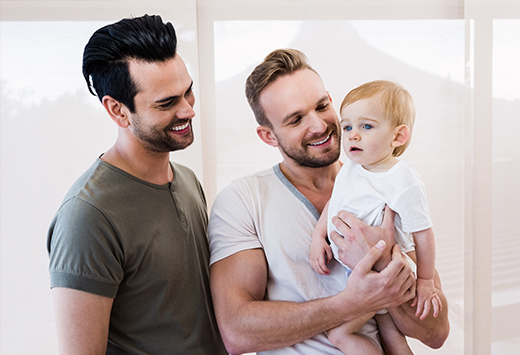If you are a prospective adoptive parent, most likely the topic of transracial adoption has come up in your research and discussions about adoption. If you are considering transracial adoption as an adoption preference, read on to learn more about the subject along with some best practices for raising your child with confidence.
What is transracial adoption?
Transracial adoption is when a child is a different race than one or both of their adoptive parents.
Thankfully, the idea that families should adopt children that look like them is becoming more and more of an antiquated belief. Nowadays, the idea of family meaning more than DNA is prominent among the adoption community, and the majority of American society is far more accepting of a family adopting outside their race. As a result, transracial adoption is becoming more and more common. To learn more about some of the nuances related to transracial adoption, check out the following report from American Enterprise Institute: Transracial Adoption in the Time of Black Lives Matter.
What are the challenges of transracial adoption?
Most beautiful things in life aren’t without their challenges and transracial adoption is no exception. One of the biggest, most difficult challenges faced by families of transracial adoption is encountering racism and close-mindedness from others, be it family members, friends, or even complete strangers. This is an unfortunate reality that we are still working through as a society, but thankfully, these days, families come in all forms and it is common to see people of various races together in one family. As we move towards a society that is more accepting, we hope this particular challenge will become less of a burden on families.
Some people against transracial adoption argue that the cultural background of the adopted child may not be appropriately respected by parents of a different race. The topic of honoring an adopted child’s heritage is a big one among prospective adoptive parents. At LifeLong Adoptions, we believe adopted children, especially those in a transracial adoption, should be raised with a strong, healthy sense of racial identity. We educate all waiting families about the importance of this and ensure they’re prepared to address the question, “How will you honor my child’s heritage?” when connecting with an expectant mother.
Transracial Adoption and the Home Study Process
In order to adopt a child of a different race, you must be specifically approved to do so as a part of your adoption home study. The reason for this is that transracial adoption adds a layer to the adoptee’s identity that can affect them into adulthood, and it is essential to ensure that the child you adopt will be raised in an environment that is safe, accepting, and loving. The home study process is also a great opportunity to discuss any questions, concerns, or thoughts about transracial adoption with your social worker.
Transracial Adoption Best Practices
1.) Openly discuss transracial adoption with your family and friends.
Before considering the possibility of transracial adoption, you need to evaluate if your family and friends will support your adoption preferences. Depending on your family, this could be a difficult conversation, but it is one that is important to have for the benefit of everyone involved, especially the adoptee. If you find yourself in the unfortunate situation where a friend or family member is resistant to the idea of you adopting a child of a different race, you should be prepared for how to handle any issues that might arise as a result. You do not want to raise a child in an environment where they are treated differently or not loved and accepted because of their skin color or cultural background.
2.) Educate yourself on racism, xenophobia, and discrimination.
The discourse on race and ethnicity is constantly evolving while there is still so much we need to learn as individuals and as a society. As the parent of a transracial adoptee, you should be open to learning and adapting to new information and discourse surrounding race and adoption.
Keep in mind that unlearning the unconscious biases that society teaches us is a lifelong practice, but this is your responsibility as a parent of a transracial adoptee. Educating yourself on issues of racism, xenophobia, and discrimination can prepare you to have constructive conversations with your child and answer any tough questions they may have as they grow up.
3.) Access resources about transracial adoption.
This blog is a good place to start your research and education about transracial adoption and there are many other resources available. Consider joining a support group for parents of transracial adoptees either online in your local community. This can help you connect with others, build a support system, and learn even more best practices surrounding transracial adoption.
There is also an abundance of books about transracial adoption and parenting a child of a different race. We recommend checking out What White Parents Should Know about Transracial Adoption: An Adoptee's Perspective on Its History, Nuances, and Practices.
4.) Do not ignore racial differences — embrace them.
As a parent of a transracial adoptee, one of the most important things to do is not ignore the race of your child or ignore how society may treat them because of their race. As their parent, you are the person responsible for helping them navigate the world and prepare them for how their race may affect their social interactions, so these are things that should be embraced and acknowledged.
In a similar vein, in order for your child to form a healthy sense of identity, they must have a safe and open environment in which they can connect with their culture. There are many different ways to do this, including exploring their culture’s cuisine, attending festivals, going to language school, and being surrounded by a community of others from their cultural background.
Something else you might want to consider is to connect your child with trusted people from their cultural background. These positive role models can be part of your child’s support network and provide additional help and guidance as they grow and experience new challenges that may be specific to their culture or race.
5.) Expose them to diversity.
Something we recommend to all parents, not just for parents of a transracial adoptee, is to ensure that your child is exposed to diversity as the grow up. Whether that means living in a multicultural neighborhood, having access to a multicultural environment, having open and meaningful conversations with your child, and reading books that celebrate different races, cultures, and backgrounds. For a more immersive experience, you can even consider traveling to different parts of the world. These are just a few ways to give your child the opportunity to interact with the different races, cultures, and backgrounds that make our world beautiful.
Remembering What’s Important
If you are a prospective adoptive parent considering transracial adoption, the most important thing you need to keep in mind is that you will be raising a child with the ultimate goal of them developing a healthy relationship with their cultural and racial identity. This will help your child navigate the world in a positive, well-rounded way.




